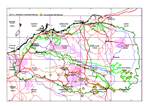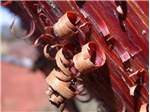Click on images
to enlarge


, BRM 8024, ORIGINAL SCAN, ADJUSTED RICHARD WOODMAN_sml.jpg)
Photographer: B.R. Maslin

Photographer: B.R. Maslin

Photographer: B.R. Maslin

Photographer: B.R. Maslin
, BRM 8024, ORIGINAL SCAN, ADJUSTED RICHARD WOODMAN_sml.jpg)
Photographer: B.R. Maslin

Minni Ritchi bark. Photographer: E. Thoma

Photographer: B.R. Maslin

Photographer: J. Maslin
, CG Dawe 213, lab photo by Fiona McCallum ADJUSTED_sml.jpg)
Seed from one herbarium voucher. Scale in mm. Photographer: F. McCallum.
Botanical name
Acacia rhodophloia Maslin, J. Adelaide Bot. Gard. 2: 317, fig. 7 (1980)
Common name
Minni Ritchi (preferred common name) and Western Red Mulga
Aboriginal name
Mantaru (Kurrama)
Description
Shrubs or trees 1.5-4 (-6) m tall, sparingly divided at or near ground level into a few main stems, crown spreading with the upper branches (of mature plants) often, but not always, tending to spread horizontally, young plants multi-stemmed and commonly with a rounded growth form. Bark attractive red Minni Ritchi, peeling off the stems in narrow strips which curl back on themselves to form scrolls on main trunks and upper branches and often branchlets. Branchlets glabrous or with an inconspicuous indumentum obscured by dry resin at the sometimes angled extremities. Phyllodes narrowly elliptic to narrowly oblong-elliptic, infrequently linear, narrowly oblong or oblong-oblanceolate, (2-) 3-7 cm long, 4-10 (-13) mm wide, reported to reach up to 10 cm long and as narrow as 2 mm wide in places outside the Pilbara (see Flora of Australia 2, 2001), coriaceous and sub-rigid, ascending to erect, straight to shallowly falcately recurved, resinous (but not sticky), glabrous or sparsely and very obscurely appressed -hairy between the nerves, dull green to grey-green; parallel longitudinal nerves numerous, fine, close together, of uniform prominence or the central one slightly more evident than the rest; apex innocuous to coarsely pungent. Inflorescences simple; peduncles 8-20 mm long; spikes 10-20 mm long and 6-8 mm wide when dry, normally about as long as or slightly longer than peduncles, may be ±globular in some areas outside the Pilbara, golden, the flowers densely arranged. Flowers normally 5-merous; calyx shortly dissected, slightly longer than half length of petals. Pods often clustered on receptacle, linear, flat, about 4-7 cm long and 3-6 mm wide, thinly crustaceous, straight to shallowly curved, glabrous, light greyish brown. Seeds longitudinal in the pods, obloid to obloid-ellipsoid, 4-4.5 mm long, 2.5-3 mm wide, shiny, dark brown to blackish; funicle expanded into a fleshy, folded, terminal, white aril.
Characteristic features
Shrubs or small trees often with the upper branches tending to spread horizontally. Bark attractive red Minni Ritchi. Phyllodes normally narrowly elliptic to narrowly oblong-elliptic, mostly 3-7 cm long and 4-10 mm wide, coriaceous and sub-rigid, ascending to erect, parallel longitudinal nerves numerous, fine, close together and ±of uniform prominence. Spikes normally about as long as or slightly longer than peduncles. Calyx slightly longer than half length of petals. Pods linear, narrow, flat (3-6 mm wide), and thinly crustaceous.
Distribution and ecology
Occurs in arid subtropical Australia from the Pilbara and Murchison regions of Western Australia eastwards to the Ehrenberg Range and south to Bloods Range and Docker Creek area in Northern Territory; there is a single record in South Australia, from north of Tarcoola. Acacia rhodophloia occurs in the south of the Pilbara region where it extends from Mt Wall west of Tom Price through the Hamersley Range to Balfour Downs Station (northeast of Newman). It grows in rocky situations in hilly country or on flats in red-brown loam or loamy clay (commonly in Mulga communities); it may occur along drainage lines but these are usually high in the landscape. In the Hamersley Range it is often found in long-unburnt, less fire-prone habitats such as rocky ridges, scree slopes and towards the summit of hills. It sometimes forms localized, almost pure stands.
Flowering and fruiting period
Appears to flower sporadically (probably dependent upon incidence and intensity of rainfall events). Pilbara collections show flowers as occurring from May to July, at which time young pods are often also found on the plants. Pods with mature seeds have been collected between late September and late October.
Variation
Acacia rhodophloia is very variable (especially in phyllode shape and size) and it is probable that the Pilbara plants and some others outside the region will ultimately be shown to constitute a species different from 'typical' A. rhodophloia (which grows in the vicinity of the Murchison River).
Taxonomy
The above description refers only to the Pilbara plants referable to this widespread, variable species.
Affinities
Acacia rhodophloia belongs to a taxonomically complex small group of species of which five are found in the Pilbara region, namely, A. adsurgens, A. atkinsiana, A. kempeana, A. rhodophloia and A. sibirica. Acacia rhodophloia is distinguished from all these species by its red Minni Ritchi bark which may extend to the branchlets. Possible hybrids between A. rhodophloia and both A. adsurgens and A. sibirica are described separately as A.? adsurgens x rhodophloia and A.? rhodophloia x sibirica. There are a number of other Minni Ritchi species in the Pilbara and of these A. rhodophloia is most closely related to A. leeuweniana and A. cyperophylla var. omearana, but is distinguished from both by its lower stature and shorter, broader phyllodes and narrower pods.
Notes
Acacia rhodophloia is killed by hot and intense fire and regenerates from seed. Mild fires may scorch individuals the subsequently regenerate however such plants are left with permanent scare on their trunk and branches.
Although phyllodes of A. rhodophloia taken from herbarium specimens have tested positive for the presence of cyanogenic glycoside, the toxic potential of this species is not known (Maslin et al. 1987). However, to our knowledge A. rhodophloia has never been incriminated in stock losses from cyanide poisoning.
Indigenous people in the Pilbara use the wood from Minni Ritchi which is extremely hard for spears and wooden tools.
Conservation status
Not considered rare or endangered.
Origin of name
The botanical name is derived from the Greek rhodo- (rose-red) and phloios (bark) in reference to the colour of the distinctive Minni Ritchi bark.
References
Maslin, B.R., Conn, E.E. and Dunn, J.E. (1987). Cyanogenic Australian species of Acacia: a preliminary account of their toxicity potential. pp. 107-111. In: J.W. Turnbull (ed.) Australian Acacias in developing countries. Proceedings of an international workshop held at the Forestry Training Centre, Gympie, Australia, 4-7 August 1986. ACIAR Proceedings No. 16. pp. 196. (Australian Centre for International Agricultural Research: Canberra.)
